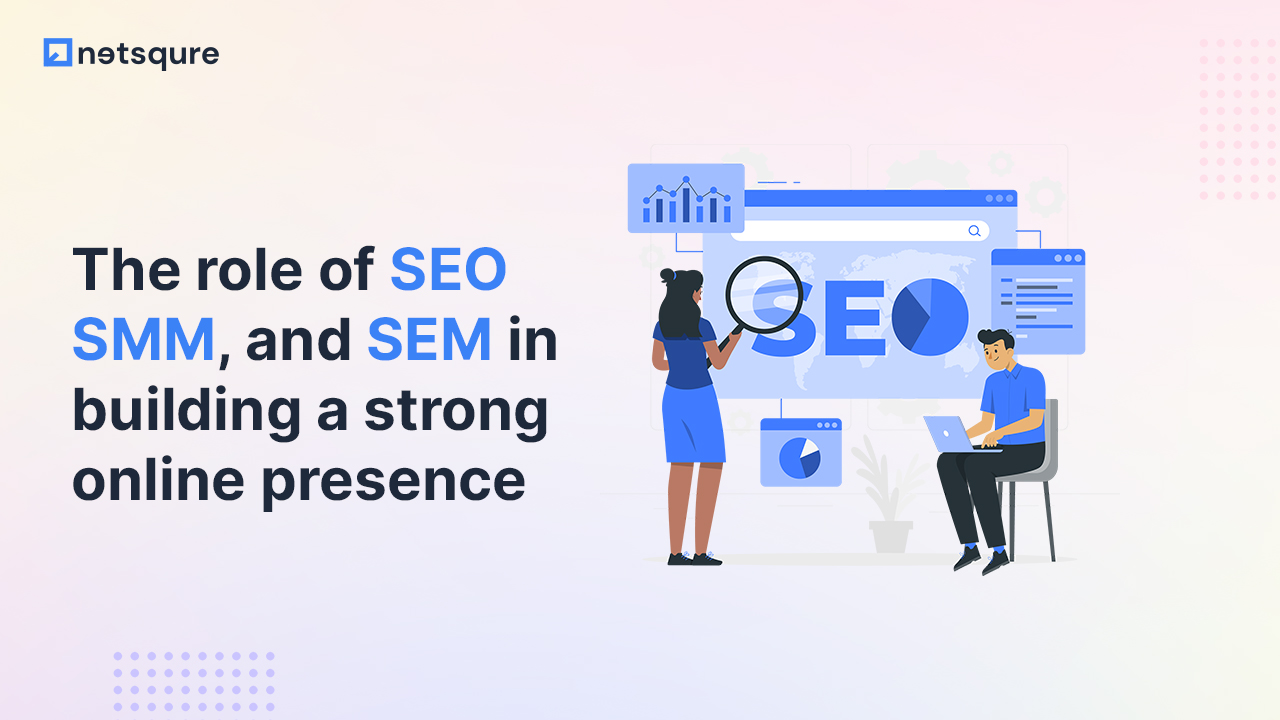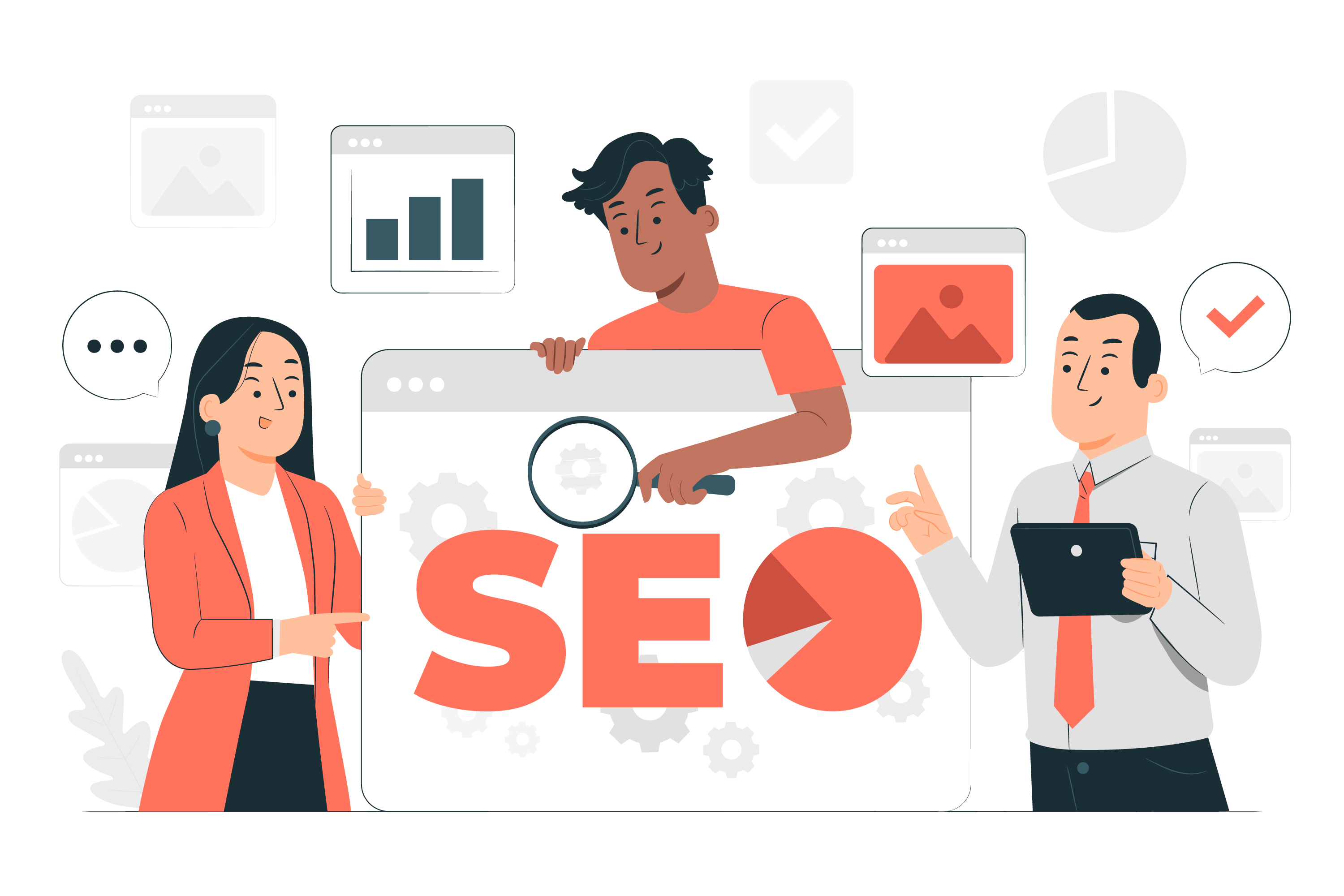The online presence of a business is extremely important in today’s digital age. With the widespread use of the web, more and more people are turning to online platforms to look for products and services. this suggests that having a robust online presence can make a big difference during a business’s success. Scroll down to find out how different strategies can help you with your brand’s online presence

SEO – Search Engine Optimization: This is the practice of optimizing the content and structure of your website so that it ranks higher in search engine results pages (SERPs) for relevant search queries. The goal of SEO is to increase organic traffic to your website and improve its visibility in search engines such as Google, Bing, and Yahoo.
SEM – Search Engine Marketing: This refers to the use of paid advertising to promote your website in search engines. This usually means bidding on keywords and creating targeted ads that appear at the top or bottom of the SERPs. The most common form of SEM is pay-per-click (PPC), where advertisers pay for each click on their ads.
SMM – Social Media Marketing: This is the practice of promoting your brand, products, or services on social media platforms such as Facebook, Twitter, Instagram and LinkedIn. The purpose of SMM is to build a strong social media presence, connect with your target audience and drive traffic to your website. This can include creating and sharing content, running ads and engaging with followers to build relationships and promote your brand. Each platform can help cater different requirements; Instagram is a visual engagement platform which can be used to showcase products. Whereas LinkedIn & Twitter are more suitable for networking.
A brief explanation of how SEO, SMM, and search engine marketing can help you build a strong online presence

SEO (Search Engine Optimization) is the process of optimizing a website or online content to improve its visibility and ranking in search engine results pages (SERPs). SEO is important for building a strong online presence by increasing visibility, credibility, and brand awareness.
Search engines use algorithms to analyze and rank websites based on various factors and display the most relevant and authoritative websites in the SERPs.
Key elements of SEO include on-page optimization (such as keyword research and optimization, content creation, and meta tags), off-page optimization (such as link building and social media marketing), and technical optimization (such as website speed and mobile-friendliness).
Techniques for optimizing website content for SEO include creating high-quality, relevant content, using keywords strategically, optimizing website structure and navigation, and building high-quality backlinks from other websites.

SMM (Social Media Marketing) is the process of promoting your brand or product through social media platforms such as Facebook, Instagram, Twitter and LinkedIn. It includes a variety of techniques such as creating and sharing content, displaying advertisements, engaging followers, and analysing performance metrics.
SMM believes that as social media platforms have become an important part of people’s lives and businesses are using these platforms to reach and interact with large audiences, there is a need to build a strong online presence. It is important. SMM helps businesses build brand awareness, increase website traffic, generate leads, and increase sales. An effective SMM strategy can help a company acquire loyal fans and build a strong online presence.
Overview of popular social media platforms: There are many popular social media platforms such as Facebook, Instagram, Twitter, LinkedIn, YouTube, and others. Each platform has its own unique features, target audience, and best practices for effective use.
Best practices for using social media for business: Businesses should create a social media strategy that aligns with their goals, target audience, and brand identity. Best practices include creating a consistent brand voice and visual identity, engaging with followers, providing valuable content, using hashtags and keywords strategically, analysing performance metrics, and staying up-to-date with platform updates and trends.
Strategies for creating engaging social media content: Effective social media content should be visually appealing, relevant to the target audience, and provide value. Strategies for creating engaging social media content include using high-quality images and videos, using humour or storytelling to capture attention, creating interactive content such as polls or quizzes, sharing user-generated content, and providing valuable information or insights.

SEM stands for Search Engine Marketing, which is a digital marketing strategy that involves using paid advertising on search engines to drive website traffic and generate leads or sales. SEM can include a variety of tactics, such as paid search ads, display ads, shopping ads, and video ads. The goal of SEM is to increase a website’s visibility and ranking in search engine results pages (SERPs) by bidding on specific keywords and demographics. SEM can be a highly effective way to reach a targeted audience, drive immediate results, and complement other digital marketing efforts.
SEM is important for building a strong online presence by allowing businesses to reach a wider audience, target specific keywords and demographics, and drive immediate results through paid advertising on search engines.
SEO focuses on optimizing a website’s content and structure to improve organic ranking in SERPs, while SEM involves using paid advertising to appear at the top of SERPs for specific keywords. SEO is a long-term strategy, while SEM can provide immediate results but requires ongoing investment. SEO traffic is free, while SEM traffic requires payment for each click or impression.
Types of paid search advertising: There are several types of paid search advertising, including:
Setting up a Google Ads campaign: To set up a Google Ads campaign, businesses need to create an account and set a budget, choose target keywords and demographics, create ad groups and ad copy, and set up conversion tracking. Google Ads provides various tools and resources to help businesses create effective campaigns, such as Keyword Planner, Ad Preview and Diagnosis, and AdWords Editor.
Best practices for optimizing SEM campaigns: To optimize SEM campaigns, businesses should follow best practices such as:
SEO, SMM, and SEM are all important digital marketing strategies that can work together to build a strong online presence. SEO focuses on optimizing website content and structure to improve organic search rankings. On the other hand, SMM refers to using social media platforms to engage customers and build brand awareness, while SEO refers to using paid advertising to increase traffic and results.
By integrating these strategies, businesses can create more comprehensive and effective digital marketing campaigns to reach wider audiences, increase brand awareness, and increase website traffic and conversions. can do.
An integrated approach to digital marketing is important because it allows businesses to leverage the strengths of each strategy and create a cohesive and consistent brand message across all channels. By integrating SEO, SMM and SEM, businesses can improve their overall digital marketing and achieve better results than if they used each strategy separately. An integrated approach also enables companies to monitor and analyse data more effectively, which can lead to better understanding and informed decision-making.
There are several useful tools for tracking metrics related to SEO, SMM, and SEM campaigns. These tools include Google Analytics, a free tool that provides insights into website traffic and visitor behavior, SEMrush, a paid tool that provides insights into SEO, SEM and social media campaigns, and Ahrefs, a paid tool that tracks social media accounts and engagement, and provides insights into backlinks, keyword rankings, and content analytics.
To make informed decisions based on data, you first need to identify your goals, such as increasing website traffic or improving conversion rates. Data can then be collected and analyzed using tools such as Google Analytics, SEMrush, or Hootsuite. It’s important to look for patterns in your data such as an increased website traffic or decreased bounce rate to identify trends. The data we collect helps us make informed decisions about how to adjust our campaigns to achieve our goals.
For example, you may need to target different keywords or adjust your ad spend. It’s also important to measure the results of your adjustments, analyze the data further, and make further improvements over time.
SEO, SMM, and SEM are key elements in building a strong online presence for your business. SEO helps increase your website’s visibility in program results, making it easier for potential customers to seek out your website. SMM enables businesses to interact with their audience and build brand awareness on social media platforms. SEM includes paid advertising campaigns that help businesses reach more users and drive more traffic to their websites. a strong online presence is important for businesses in today’s digital age. It helps increase brand awareness, improve customer retention and loyalty, and ultimately increase sales and revenue.
By implementing effective SEO, SMM, and SEM strategies, businesses can build a strong online presence and remain competitive within the industry. To grow their online presence, businesses should start by setting clear goals and objectives.
Next, create a comprehensive digital marketing plan that has SEO, SMM, and SEM strategies. This plan should be regularly reviewed and adjusted supported performance data to make sure desired results are being achieved. it’s also important for businesses to prioritize providing quality content that’s relevant and valuable to their audience. this may assist you establish yourself as an authority in your industry and drive traffic to your site.
In summary, businesses should prioritize building a strong online presence through effective SEO, SMM, and SEM strategies. By setting clear goals, creating a comprehensive digital marketing plan, and providing quality content, businesses can improve their online presence, reach a wider audience, and ultimately increase sales can increase sales.